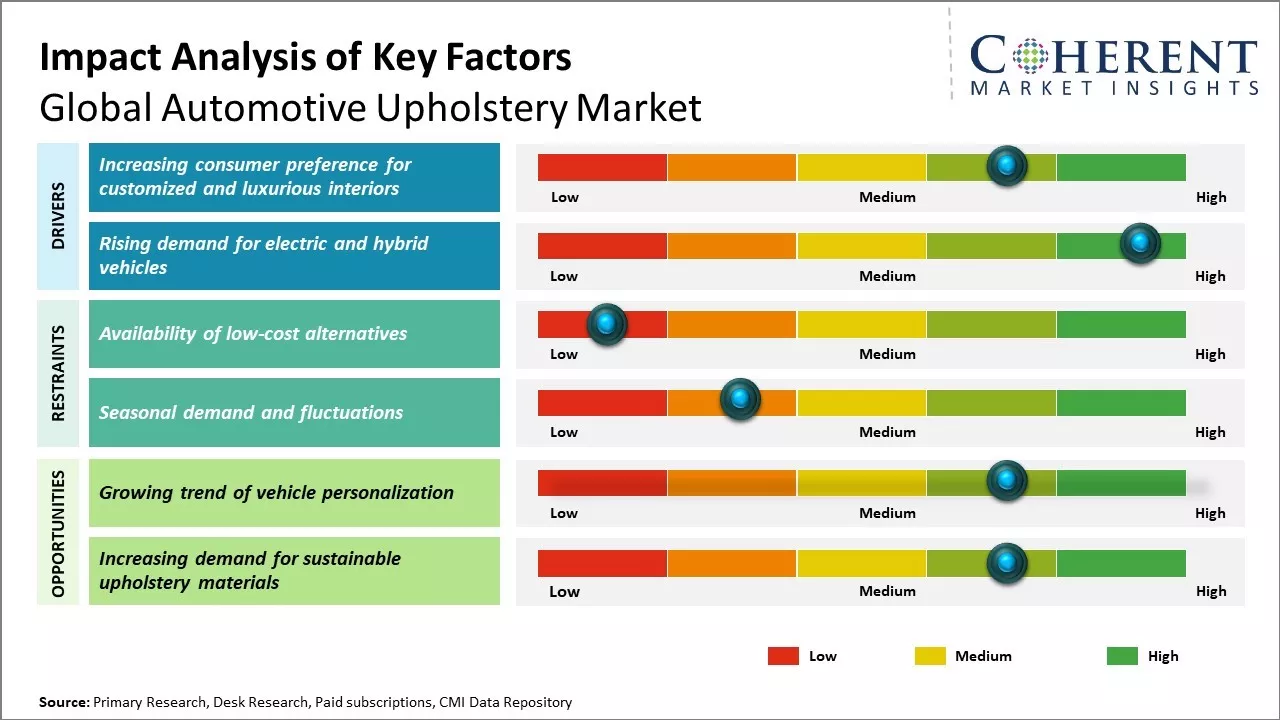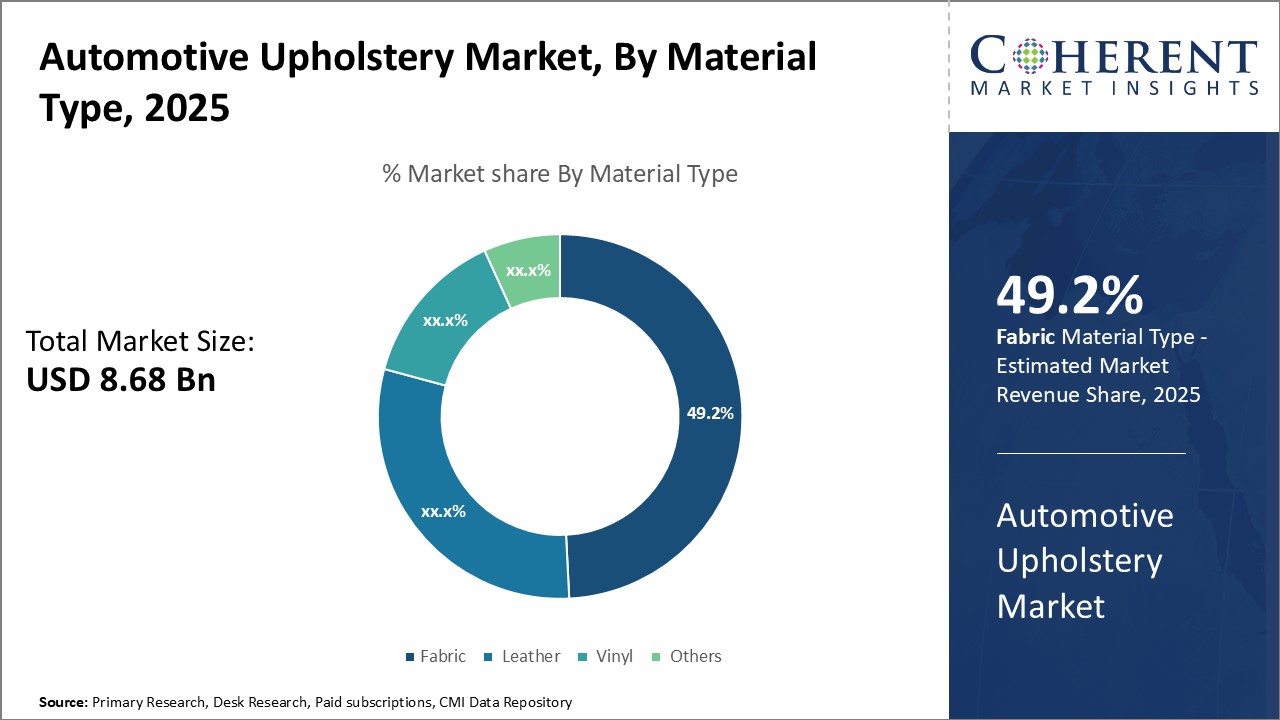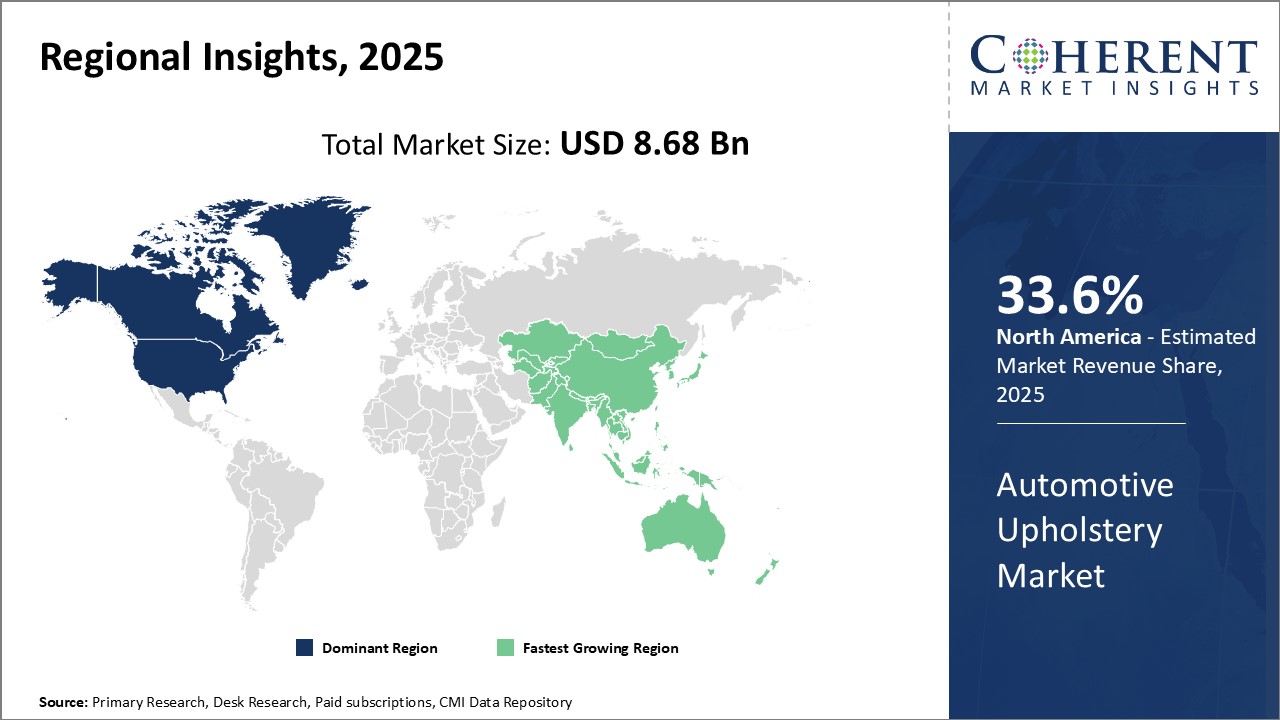Global Automotive Upholstery Market is estimated to be valued at USD 8.68 Billion in 2025 and is expected to reach USD 14.98 Billion by 2032, exhibiting a compound annual growth rate (CAGR) of 8.1% from 2025 to 2032.

Discover market dynamics shaping the industry: Request sample copy
The growing demand for premium and luxury vehicles equipped with premium upholstery materials like leather is driving the market growth. The automotive upholstery market is expected to witness significant growth over the forecast period. This is attributed to the rising automobile production across the globe. Additionally, the increasing demand for luxurious and comfortable driving experience among consumers is augmenting the demand for quality upholstery materials in automotive interiors.
Increasing consumer preference for customized and luxurious interiors
The automotive industry has seen major developments in the recent past with technological advancements and rising disposable incomes of consumers. Owners want their vehicles to reflect their personality and style. This has led to increased demand for premium and customized upholstery options from automakers. Consumers want seating materials that offer high durability as well as top-notch comfort on long drives. Leather upholstery is the top preference owing to its plush feel and upscale appeal. Synthetic leather variants are also gaining traction as they provide a luxurious look at lower costs.
Customers can now select from a wide palette of colors, textures, and material combinations based on their aesthetic preferences. Some variants on demand include nappa leather, alcantara suede, perforated leather, embossed leather, and two-tone leathers. New technologies are also being adopted to embed heating and ventilation features in upholstery for additional comfort. This has spurred growth in the customized and luxury upholstery market. Companies specializing in niche automotive trims have emerged to cater to special consumer demands. The competitive market landscape is prompting upholstery manufacturers to innovate with new design patterns, motifs, and finishes. With rising disposable incomes, demand for sophisticated interiors is expected to drive significant gains in the premium automotive upholstery industry.
In May 2022, Toyota Boshoku Corporation, a leading manufacturer of automotive interior components, participated in the JSAE’s online Automotive Engineering Exposition 2021, where it showcased its innovative seat cover featuring a fatigue estimation system designed to enhance safety significantly.

Get actionable strategies to beat competition: Request sample copy
Rising Relevance of Electric and Hybrid Powertrains
Governments across the globe are actively pushing stringent emission regulations to curb air pollution and transition towards more sustainable transportation solutions. Major automakers like Adient PLC, BASF SE, Faurecia SE, Freudenberg Group, Grupo Antolin Irausa, S.A., Lear Corporation, MarvelVinyls, Sage Automotive Interiors, etc. are responding by accelerating investments in electric vehicles (EVs) and hybrid technologies. While the initial costs of EVs are higher than conventional vehicles, subsidies and falling battery prices are making them more accessible for buyers. Automakers realize that attractive upholstery with user-friendly cabin designs and features can entice environment-conscious consumers. Advancements in lithium-ion batteries have also enabled longer driving ranges for EVs.
As the market share of EVs and hybrids rises, upholstery manufacturers are tailoring their offerings to suit these emerging powertrain trends. For example, since EVs generate less noise and heat inside the cabin, new-age upholstery focuses more on aesthetic looks along with breathability. Lightweight synthetic materials are gaining favor for their lower carbon footprint. Innovations around antimicrobial and easy-to-clean coatings are crucial in confined EV cabins. The unique interiors of EVs also necessitate ultra-modern upholstery styling with specialized designs.
Key Takeaways from Analyst:
Rising vehicle production and sales across major markets will drive demand for upholstery materials like fabric, leather, and vinyl. Automakers are also offering more upholstery options to customers, allowing them to customize the interior appearance of their vehicles. This increasing flexibility and customization are working as a major growth driver for the market. At the same time, growing preference for SUVs, luxury and premium vehicles which use more upholstery materials per vehicle is creating opportunities for manufacturers.
On the other hand, pricing pressure on automakers may limit their ability to use higher-priced upholstery options. Also, volatility in raw material costs, especially that of leather, remains a challenge. Sustainability issues related to use of leather and long lead times also act as barriers. However, growing focus on eco-friendly and recycled materials is opening up new avenues for upholstery players.
Market Challenge - Availability of low-cost alternatives
One of the major challenges faced by the global automotive upholstery market is the availability of low-cost alternatives. With rising inflation and fluctuating raw material costs, consumers are looking for cheaper options to customize the interiors of their vehicles. Low-cost leatherette and polyester-based upholstery materials from Asian and Eastern European manufacturers provide a convincing alternative to genuine leather and textile upholstery at a fraction of the price. While these substitutes may not match the feel and appearance of premium upholstery solutions, their affordability is a big selling point. The influx of low-cost alternatives from unorganized players has put pricing pressure on established upholstery brands. Retaining brand loyalty and customers who seek quality has become challenging in this environment. Innovation in material technology and value-added services would be key for upholstery brands to sustain demand from cost-conscious buyers.
Market Opportunity: Growing trend of vehicle personalization
The global automotive upholstery market is presented with significant opportunities owing to the rising trend of vehicle personalization. Customers today want their vehicles to reflect their personal style and tastes beyond just the functionality. The ability to customize and personalize the interior décor, seating, dashboard trims and other elements is an important decision factor for many buyers. This has boosted the demand for a wide variety of upholstery materials, textures, finishes and colors. Automakers and upholstery brands are witnessing more demands for customization options from their discerning clientele. By expanding their palette of materials, design services and do-it-yourself solutions, upholstery players can tap into the lucrative opportunity arising from customers' urge to stand out from the crowd with uniquely styled car cabins. A strong portfolio of personalization features would be important to capture the demands of modern customers.

Discover high revenue pocket segments and roadmap to it: Request sample copy
Insights By Material Type - The fabric segment is leading the market due to its comfort and breathability
In terms of Material Type, the Fabric segment is estimated to hold 49.2% share of the market in 2025 owing to its comfort and breathability. Fabric upholstery provides a soft feel and is soothing to touch, enhancing the overall riding comfort inside the vehicle. It absorbs sweat and moisture from the skin, keeping passengers cool during extended driving hours. The breathable nature of fabric upholstery prevents the accumulation of heat inside the car. In addition, fabrics come in a wide variety of styles, designs, and textures, allowing customers to choose an option that best match their personality and taste. Luxury automakers especially rely on high-quality, premium fabric upholstery to offer passengers a comfortable and exclusive in-cabin experience.
For instance, in October 2022, Lear Corporation, a global automotive technology leader based in Southfield, Michigan, announced the development of ReNewKnit, a fully recyclable sueded material set to launch in seating and door panel applications with a global automaker in 2024. This innovative textile is the first of its kind in the automotive industry, made entirely from recycled plastic bottles and manufactured at Lear's facilities in the U.K. and Poland using 100% renewable electricity. ReNewKnit fibers are spun from polyester yarn and feature a foam-free recycled fleece backing, significantly reducing water and energy consumption during production while promoting sustainability at the end of the material's life cycle.
Insights By Vehicle Type - Passenger Cars leads the market due to large production and sales volume
In terms of Vehicle Type, the Passenger Cars segment is estimated to hold 64% share of the market in 2025 owing to the large production and sales volume of passenger vehicles worldwide. Automotive upholstery manufacturers can take advantage of substantial economies of scale by focusing on the passenger car segment. Within this segment, upholstery solutions need to be versatile enough to suit the different classes of passenger cars from compacts to luxury sedans. Upholstery materials thus need to offer the required levels of comfort, support, durability and aesthetics for diverse passenger vehicle body designs. The segment also allows for constant innovation in terms of styles, designs and integration of new features in car seats.
Insights By Distribution Channel - OEMs (Original Equipment Manufacturers) dominate the market by ensuring quality and standards
In terms of Distribution Channel, the OEMs (Original Equipment Manufacturers) segment is estimated to hold 72.6% share of the market in 2025 as automakers strive to ensure consistent quality and durability standards throughout the vehicle production process. Partnering directly with upholstery suppliers enables automakers to integrate upholstery designs and specifications at the conceptualization stage itself. This helps match upholstery designs with other interior components. Specifying upholstery materials and processes also allows OEMs to optimize production, meet regulatory compliance, enhance reliability, and extend warranty coverage. With original upholstery fitted by automakers, buyers are assured of a high-quality in-cabin experience without additional costs or assembly challenges.

Need a Different Region or Segment? Customize now
North America remains the dominant region in the global automotive upholstery market with an estimated 33.6% share in 2025, led mainly by the U. S. The large presence of automotive OEMs such as General Motors (GM), Ford Motor Company, Stellantis, Toyota Motor Corporation, Honda Motor Company, etc. and a well-established automotive supply chain in the region provides it an edge. Major automakers like General Motors, Ford, and FCA continually invest in new vehicle programs and upgrades, driving the need for upholstery. Furthermore, the high average annual miles driven by Americans has positively impacted the replacement market for car seats and interiors over the years.
However, Asia Pacific has emerged as the fastest growing market for automotive upholstery globally. Countries like China, India, Japan, and South Korea are witnessing massive automobile production as well as rising disposable incomes. The presence of automotive hub cities with major cluster of OEMs and tier-1 suppliers provides Asia Pacific economies of scale. For example, Chinese suppliers exporting upholstery at competitive prices to their domestic automakers have increased China's exports to other Asian and European markets.
While North America and Europe dominated the luxury vehicle market in the past, Asia Pacific is fast catching up. With rising prosperity, more consumers are opting for imported luxury brands which use high-quality upholstery and material. This is enabling suppliers to cater to diverse specifications for different automotive groups. The suppliers are also localizing their operations by setting up manufacturing units in key Asian countries. This helps them reduce transportation costs and address currency risks to better serve the fast-growing automotive markets.
Automotive Upholstery Market Report Coverage
| Report Coverage | Details | ||
|---|---|---|---|
| Base Year: | 2024 | Market Size in 2025: | USD 8.68 Bn |
| Historical Data for: | 2020 To 2024 | Forecast Period: | 2025 To 2032 |
| Forecast Period 2025 to 2032 CAGR: | 8.1% | 2032 Value Projection: | USD 14.98 Bn |
| Geographies covered: |
|
||
| Segments covered: |
|
||
| Companies covered: |
Adient PLC, BASF SE, Faurecia SE, Freudenberg Group, Grupo Antolin Irausa, S.A., Lear Corporation, MarvelVinyls, Sage Automotive Interiors, SEIREN Co., Ltd., Seating Incorporateds, Suminoe Textile Co., Ltd., The Acme Group, Toyota Boshoku Corporation, Yanfeng Automotive Interiors, and Zhejiang Feihao Automobile Decoration Co., Ltd. |
||
| Growth Drivers: |
|
||
| Restraints & Challenges: |
|
||
Uncover macros and micros vetted on 75+ parameters: Get instant access to report
Share
Share
About Author
Gautam Mahajan is a Research Consultant with 5+ years of experience in market research and consulting. He excels in analyzing market engineering, market trends, competitive landscapes, and technological developments. He specializes in both primary and secondary research, as well as strategic consulting across diverse sectors.
Missing comfort of reading report in your local language? Find your preferred language :
Transform your Strategy with Exclusive Trending Reports :
Frequently Asked Questions
Joining thousands of companies around the world committed to making the Excellent Business Solutions.
View All Our Clients
US Reciprocal Tax Impact Analysis On Automotive Upholstery Market
Stay updated on tariff changes with expert insights and timely information